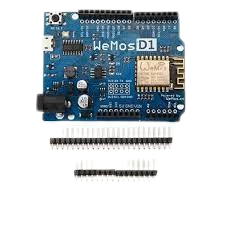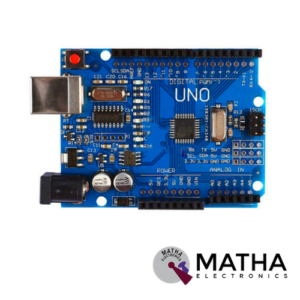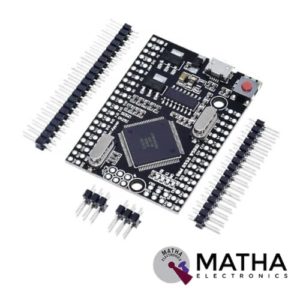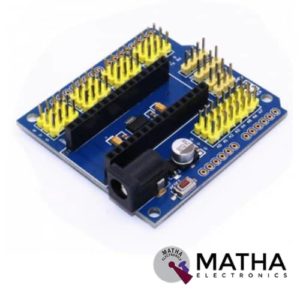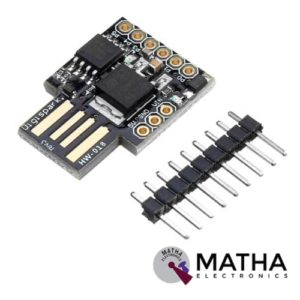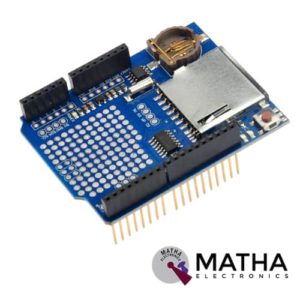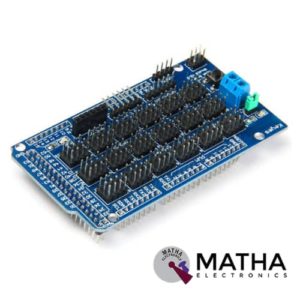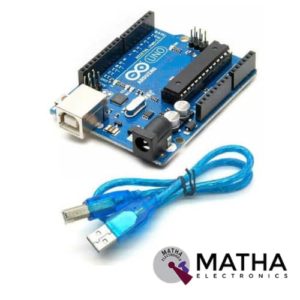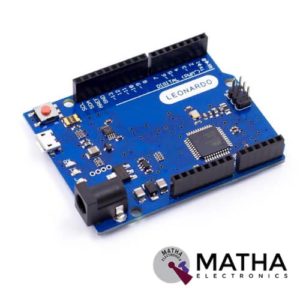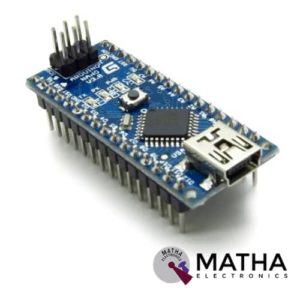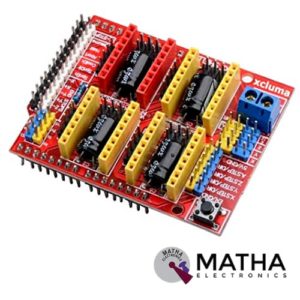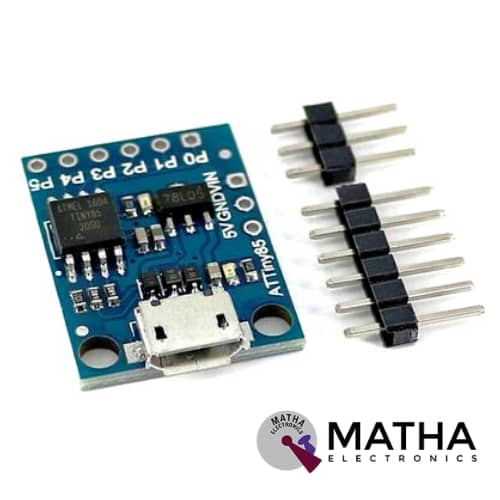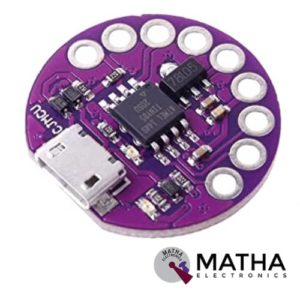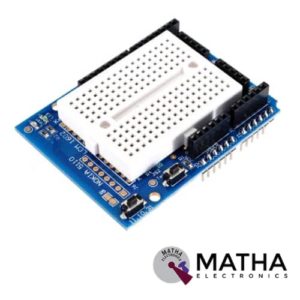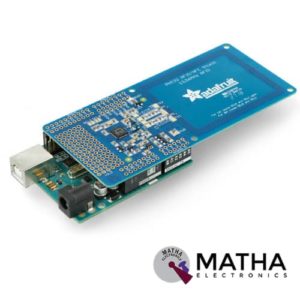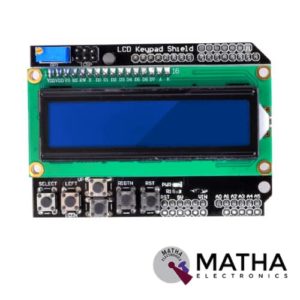Arduino Pro Mini
Arduino Uno R3 Clone SMD
- Microcontroller: ATmega328 SMD.
- Operating Voltage: 5V.
- Supply Voltage recommended: 7-12V DC.
- Digital I/O Pins: 14 (of which 6 provide PWM output).
- Analog Input Pins: 6.
- DC Current per I/O Pin: 40 mA.
- DC Current for 3.3V Pin: 50 mA.
- Flash Memory: 32 KB (ATmega328) of which 0.5 KB is used by the bootloader.
- SRAM: 2 KB (ATmega328).
- EEPROM: 1 KB (ATmega328).
- Clock Speed: 16 MHz.
Arduino Mega Pro Mini CH340 Development Board
- Microcontroller ATmega2560
- USB-TTL converter: CH340
- Power Out:5V-800mA
- Power IN.: 5V
- Power IN. VIN/DC Jack:5V
- Power Consumption: 5V 220mA
- Logic Level: 5V
- USB: Micro USB
- Clock Frequency: 16MHz
- Operating Supply Voltage: 5V
- Digital I/O: 54
- Analog I/O: 16
- Memory Size: 256kb
- Data RAM Type/Size: 8Kb
- Data ROM Type/Size: 4Kb
- Interface Type : ISP
- Operating temperature −40С°/+85С°
- Length x Width :38mm×54mm
Prototype Shield V3.0 For Arduino Mega with breadboard
- The shield can support being fully assembled with Arduino MEGA
- Support soldering components directly on this shield
- Support sticking the mini breadboards on this shield
- Reset button up top
- Mainboard aureate quadrate
- With SOP28 SMT components encapsulation
- With PWR & STAT indicator
- Breadboard Points : 170
- Shield Size (mm) : 102×56
- Breadboard Size (mm) : 48×34
- Weight (gm) :35
NANO / UNO Multi-Purpose Expansion Board
- The Sensor Shield makes your connections with the Arduino Nano much easier
- It is compatible with Arduino Nano 2.0 and 3.0
- The shield has up to 8 analogue pins, 13 digital I/O pins, and Aref with 3 pin connectors (GND, Vcc, Signal).
- Consists of an independent I2C port with 4pins (SDA, SCL, GND, and Vcc) and UART (Rx, Tx, Vcc, and GND).
- Reset button onboard and a female jack for external power supply
- Material: FR-4 Epoxy Glass Fibre Board
- IO port leads all digital and analogue IO ports, each IO port has positive and negative power supply interface standards.
- Leads to an I2C interface on the motherboard, convenient and I2C devices connected.
- Size: Approx. 57x53x8mm
L298P Motor Shield motor driver
- L298P based Arduino motor driver shield
- Operating Voltage 5V to 12V
- Motor controller L298P, Drives 2 DC motors or 1 stepper motor
- The logical part of the input voltage VD: 5V
- Driven part of the input voltage VS: VIN Input 6.5 ~ 12V, PWRIN 4.8 ~ 35V input
- The logical part of the work current Iss:<36mA
- Driven part of the operating current Io:<2A
- Current sensing 1.65V/A
- Free running stop and brake function
- Maximum power dissipation: 25W (T = 75 Celsius)
- Max current 2A per channel or 4A max (with external power supply)
- Control signal input level: High 2.3V
- Onboard Bluetooth interface, you can directly plug, no wiring required.
- The board with L298P motor drive chip, directly with the motherboard digital I/O port (D10, D11, D12, D13), without cumbersome wiring.
- Onboard buzzer (D4), you can set the reverse alarm ringtones.
- D2, D3, D5, D6, D7, D9 are not occupied by the digital interface.
- A 0 – A 5 six analogue interfaces.
- Forward and Backward steering are indicators
Ethernet Shield
- Based on the W5100Based on the Wiznet W5100 allows an Arduino board to connect to the internet.
- Stackable Design, can directly be supported by Arduino official Ethernet Library.
- Supports up to four simultaneous socket connections
- Can be used to store files for serving over the network.
- Compatible with the Arduino Duemilanove (168 or 328), Uno as well as Mega (1280/2560).
- Can be accessed using the Mini SD TF library.
- The current shield has a Power over Ethernet (PoE) module designed to extract power from a conventional twisted-pair Category 5 Ethernet cable.
- IEEE802.3af compliant
- Low output ripple and noise (100mVpp)
- Overload and short-circuit protection
- 1500V isolation (input to output)
Attiny 5 Version 2
- High Performance, Low Power AVR® 8-Bit Microcontroller
- Non-volatile Program and Data Memories
- 8K Bytes of In-System Programmable Program Memory Flash
- Endurance: 10,000 Write/Erase Cycles
- 512 Bytes In-System Programmable EEPROM
- Endurance: 100,000 Write/Erase Cycles
- 512 Bytes Internal SRAM
- Peripheral Features
- High-Frequency PWM Outputs with Separate Output Compare Registers
- USI – Universal Serial Interface (12C, SPI, 1-wire) with Start Condition Detector
- 10-bit ADC
- Single-Ended Channels
- 2 Differential ADC Channel Pairs with Programmable Gain (1x, 20x)
- Speed Grade: 0 – 10 MHz @ 2.7 – 5.5V, 0 – 20 MHz @ 4.5 – 5.5V
- Low Power Consumption
- Active Mode:1 MHz, 1.8V: 300 µA
Attiny 5 Version 1
- High Performance, Low Power AVR® 8-Bit Microcontroller
- Non-volatile Program and Data Memories
- 8K Bytes of In-System Programmable Program Memory Flash
- Endurance: 10,000 Write/Erase Cycles
- 512 Bytes In-System Programmable EEPROM
- Endurance: 100,000 Write/Erase Cycles
- 512 Bytes Internal SRAM
- Peripheral Features
- High-Frequency PWM Outputs with Separate Output Compare Registers
- USI – Universal Serial Interface (12C, SPI, 1-wire) with Start Condition Detector
- 10-bit ADC
- Single-Ended Channels
- 2 Differential ADC Channel Pairs with Programmable Gain (1x, 20x)
- Speed Grade: 0 – 10 MHz @ 2.7 – 5.5V, 0 – 20 MHz @ 4.5 – 5.5V
- Low Power Consumption
- Active Mode:1 MHz, 1.8V: 300 µA
UNO R3 Transparent Case
- Material: A grade acrylic sheet.
- For Arduino UNO R3 Development Board only.
- With screw copper pillar and installation instructions.
- To protect your little computer against damages, dust and scratches Clear Top and Bottom.
- This case provides easy access to all ports.
- It requires no tools for easy assembly and disassembly.
- Simply Clicks Together Enclosure.
Wemos D1 WiFi Esp8266 Development Board Uno Compatible Program
- Microcontroller: ESP-8266EX
- Operating Voltage: 3.3 V
- Digital I/O Pins: 11
- Analog Input Pins 1(Max input: 3.2V)
- Clock Speed: 80MHz/160MHz
- Flash: 4M bytes
- Good stability.
- 11 digital input/output pins, all pins have interrupt/PWM/I2C/one-wire supported(except for D0)
- 1 analog input(3.2V max input)
- Micro USB connection
- Compatible with Arduino
- Support OTA wireless uploading
- On-Board Switching Power Supply:
- Micro USB connection
- Compatible with Arduino
- Support OTA wireless uploading
Screw Shield Expansion board for Arduino
- Arduino terminal to provide the IO, port connection.
- 81 posts quality, reliable, convenient, durable.
- Combined with the Proto Shield, the middle can be used as a prototype expansion board.
- Double-sided PCB Prototyping extended area vias connecting the front sides can be welded components.
- The middle section can be placed small bread plate, convenient test extend
DTMF Shield
- MT8870 Decoder IC.
- 4 Output digital pins.
- Operates on 5V
- Includes MT8870 DTMF Receiver IC
- Receives and Converts Standard DTMF Codes
- Remotely Switch Devices from Anywhere Using the Phone
- Easily Connects to Most Microcontrollers or Roboduino Board
- Low Power Consumption
- 5 On-Board LED's For Data Received Indication
- Standard Header Connections for Control System Connection
- Audio socket for application
- Speaker connector for audio sound checking.
- Microphone connector for over the air remote control system( note, due to environmental noise, without any filtering system this method is not recommended)
- Dimension: 37x37x9mm
USB Host Shield
- Works with standard (dual 5/3.3V) and 3.3V-only (for example, Pro Arduino) boards.
- Operates over the extended -40°C to +85°C temperature range
- Complies with USB Specification Revision 2.0 (Full-Speed 12Mbps Peripheral, Full-/Low-Speed 12Mbps/1.5Mbps Host)
- Supports HID devices, such as keyboards, mice, joysticks, etc.
- Compatible with Mass storage devices, such as USB sticks, memory card readers, external hard drives (FAT32 Type File System – Mega Arduino only).
Bluetooth Relay Shield
CAN Bus Shield
- Implements CAN V2.0B at up to 1 Mb/s
- Industrial standard 9 pin sub-D connector
- OBD-II and CAN standard pinout selectable.
- Changeable chip select pin
- Changeable CS pin for TF card slot
- Changeable INT pin
- Screw terminal that easily to connect CAN_H and CAN_L
- Arduino Uno pin headers
- Grove connectors (I2C and UART)
- SPI Interface up to 10 MHz
- Standard (11 bit) and extended (29 bit) data and remote frames
- Two receive buffers with prioritized message storage
Joystick Shield
SD Card shield V4.0 for Arduino UNO
- Standard SD card, SDHC card and TF card compatible
- 3.3v and 5v logical voltage compatible
- 2.6-3.6v DC power supply
- UART Grove & I2C connection compatible
- Fully supported SD Library
- Minimal number of SPI port
- Jumpers provided for configuring Arduino SPI port pins
- Onboard toggle switch for SD card select type
- Truly stackable
- Prototype expand Library support
- Size: 53mm x 47mm
- Weight: 35g
MEGA Sensor Shield V2.0
- PIN13 Stat & Power LED indicator
- Digital IO Ports D0-D53
- Analog IO Ports A0-A15
- Reset Button up to the top
- External Power In
- SD Card Interface
- Ultrasonic Interface
- ISP Interface
- Bluetooth Interface
- APC220 Interface
- PCB finest Immersion Gold processing
- Plug it easier to set up a variety of commonly used module interface
Sensor Shield V5 Expansion Board For Arduino
- Retain the merits of the V4.0 version
- Laminated design
- PCB immersion gold processing technology
- IIC interface
- Bluetooth module communication interface
- SD card module communication interface
- APC220 Wireless RF modules communication interface
- RB URF v1.1 ultrasonic sensors interface
- 12864 LCD string of line and parallel interface
- 32 servo controller interface
Arduino Duemilanove Development Board with USB Cable
- Microcontroller: ATmega168/ATmega 328
- Operating Voltage: 5V
- Input Voltage: 7-12V
- Input Voltage: 6-20V
- Digital I/O Pins: 14 (of which 6 provide PWM output)
- Analog Input Pins: 6
- DC Current per I/O Pin: 40 mA
- DC Current for 3.3V Pin: 50 mA
- Flash Memory: 16 KB (ATmega168) or 32 KB (ATmega328) of which 2 KB used by the bootloader
- SRAM: 1 KB (ATmega168) or 2 KB (ATmega328)
- EEPROM: 512 bytes (ATmega168) or 1 KB (ATmega328)
- Clock Speed: 16 MHz
Arduino Leonardo R3
- Board Mode: LEONARDO R3
- Microcontroller: ATmega32u4
- Operating Voltage: 5V
- Input Voltage (Recommended): 7-12V
- Input Voltage (limits): 6-20V
- Digital I/O Pins: 20
- PWM Channels: 7
- Analog Input Channels: 12
- DC Current per I/O Pin: 40 mA
- DC Current for 3.3V Pin: 50 mA
- Flash Memory: 32 KB
- SRAM: 2.5 KB (ATmega32u4)
- EEPROM: 1 KB (ATmega32u4)
- Clock Speed: 16 MHz
Arduino Nano V3.0
- Microcontroller: Atmel ATmega328 SMD Package
- Operating Voltage (logic level): 5 V
- Input Voltage (recommended): 7-12 V
- Input Voltage (limits): 6-20 V
- Digital I/O Pins: 14 (of which 6 provide PWM output)
- Analog Input Pins: 8
- DC Current per I/O Pin: 40 mA
- Flash Memory: 32 KB (of which 2KB used by bootloader)
- SRAM: 2 KB
- EEPROM: 1 KB
- Clock Speed: 16 MHz
- Automatic reset during program download
- Power OK blue LED
- Green (TX), red (RX) and orange (L) LED
- Auto-sensing/switching power input
- Small mini-B USB for programming and serial monitor
- ICSP header for direct program download
- Standard 0.1” spacing DIP (breadboard friendly)
- Manual reset switch
- Dimensions: 0.70” x 1.70”
MEPUNO ROBOT CONTROLLER BOARD
- Microcontroller ATMEGA328 P.
- Crystal for the microcontroller: 16 MHZ
- USB type B connector
- 5volt, 12 volts regulated circuit.
- Two separate regulated 5volt power supplies.
- On-Board On/Off switch.
- OnBoard DC jack for powering up using adaptors.
- On-Board Reset Switch.
- Onboard L293D dual DC motor driver.
- Onboard TSOP IR receiver.
- On Board 3 user LEDs (with jumper selection), TX/RX indication LEDs.
- On-board connectors for analogue interfacing.
- On Board Buzzer Interface.
- On-Board PWM Interfacing.
- On board FTDI Driver for adruino.
- Berg headers for external interfacing.
- Supports I2C /3 WIRE /RF/USART serial communication standards.
Arduino Compatible Nokia 5110 Prototype Proto Shield Expansion Board
- Supports Nokia5110 display
- Standard 0.1"x0.1" prototyping grid with big pads
- Comes with Stacking headers and plain header, choose whichever you want when soldering together
- IC pattern for adding DIP ICs up to 20 pins
- Power rails down the middle and sides
- Reset button and an extra general use button
- 2 3mm general use LEDs, red and green, as well as 2 matching resistors
- A pass-thru ICSP stacking header so you can stack any kind of shield on top, and/or use an AVR programmer
- Surface-mount chip area for up to 14 SOIC size parts
- Compatible with tiny breadboards
- Every pin is brought out
- Gold plated pads
- 2 x 0.1uF capacitors on either side for extra power stability
HC-05 Bluetooth Shield for Arduino
- Bluetooth serial port Profile
- Bluetooth protocol: Bluetooth Specification v2.0+EDR
- Frequency: 2.4GHz ISM band
- Communication Range: 10M
- Serial Bluetooth module for Arduino
- Can operate in Master, Slave or Master/Slave mode
- UART interface (TTL) with programmable baud rate (SPP firmware installed)
- Default baud rate: 38400(CMD MODE) / 9600(DATA MODE), data bits: 8, stop bit: 1, Parity: No parity
- Onboard PCB antenna
- FCC ID certificated
2.4″ Inch Touch Screen TFT Display Shield for Arduino
- 4″ Touch LCD TFT display module for Arduino
- 240*320 pixels resolution
- Ability to display 262000 different colours
- The shield comes equipped with a microSD card slot.
- SPFD5408 controller with built-in video RAM buffer
- 8-bit digital interface, plus 4 control lines
- 5V compatible. Use with 3.3V or 5V logic
- On-board 3.3V 300mA LDO regulator
- Uses digital pins 5-13 and analogue 0-3. That means you can use digital pins 2, 3, and analog 4 and 5. Pin 12 is available if not using the microSD
- Works with any Arduino Uno and mega compatible boards
- Resolution: 240320 pixels
- Supply voltage: 5V
- Working temperature: -30C ~ 70C
- Dimension: 72*52*12mm
ESP8266 WIFI Shield
- Operating voltage 5V (supplied from the Arduino Board)
- Connection via: 802.11b/g networks
- Encryption types: WEP and WPA2 Personal
- Connection with Arduino on SPI port
- on-board micro SD slot
- ICSP headers
- FTDI connection for serial debugging of WiFi shield
- Mini-USB for updating WiFi shield firmware
- 32-bit RISC architecture
- The processor can operate at 80MHz / 160MHz
- 32MB flash memory
- 64kB for instructions
- 96kB for data
- Operates in AP, Station or AP + Station mode
- It has 11 digital pins
- It has 1 analogue pin with 10-bit resolution
- Digital pins except the D0 have interrupts, PWM, I2C and one wire
- Programmable through USB or WiFi (OTA)
- Compatible with Arduino IDE
- Compatible with modules and sensors used in Arduino
PN532 NFC/RFID Controller Shield for Arduino
- PN532 chip-set
- Operating Voltage : 3.3V ~ 5v
- Support I2C, SPI
- I2C: 3.3V ~ 24V TTL
- SPI: 3.3V TTL with 100-ohm resistors in series
- Plug and play, Arduino compatible
- Built-in PCB Antenna
- Communication distance:10cm
- Easy to change mode
- NFC/RFID PN532 shield including a tuned 13.56MHz stripline antenna
- 36-pin 0.1" header for attaching the shield to an Arduino.
- Compatible with Arduino Mega 1280 & 2560, Diecimila, Duemilanove, and UNO
16×2 (1602) LCD Keypad Shield
- Operating Voltage:5V
- 5 Push buttons.
- RST button to reset Arduino program.
- Integrate a potentiometer for adjusting the backlight.
- Expanded available I/O pins.
- Blue light with white characters.
- Uses 4 Bit Arduino LCD Library
- Screen contrast adjustment
- Arduino Reset button
- The keypad consists of 6 keys select, up, right, down, left and reset.
- To save the digital IO pins, the keypad interface only uses one ADC channel.
- The key value is read out through a 5 stage voltage divider.



